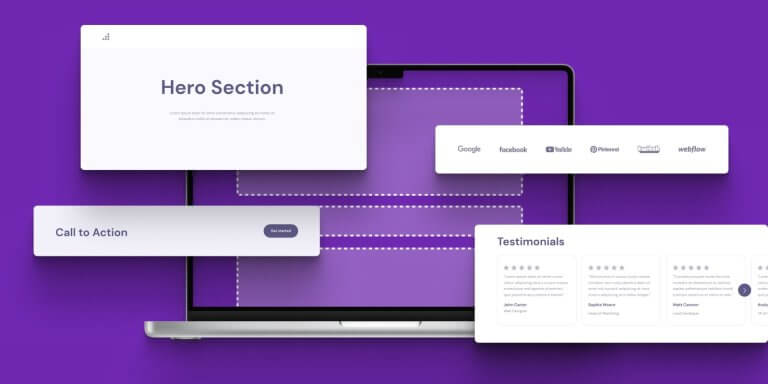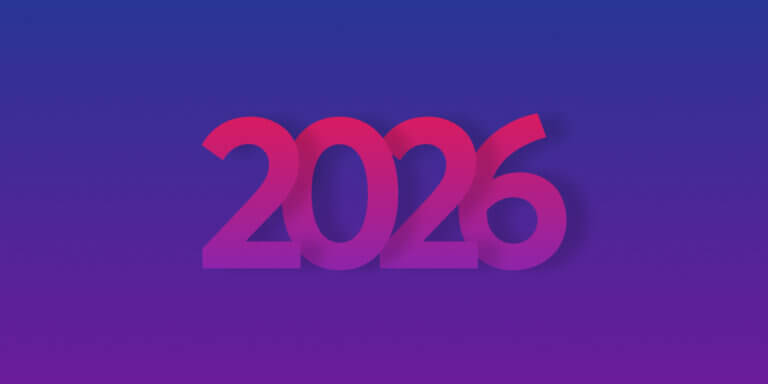Table of Contents
The first interaction a potential learner has with your course often comes in the form of a well-crafted course description. This description serves as a gateway to understanding the essence, content, and potential impact of your educational offering.
Writing an effective class course description requires more than a simple enumeration of topics, though; it demands the artful fusion of clarity, persuasion, and engagement. Gone are the days of dry and formal language – today’s learners crave a connection with the instructor and want to know what the course entails before they decide to join in.
If you want to instill excitement and, ultimately, entice learners to embark on an educational journey with you as the expert, you need to say goodbye to the ordinary and hello to a description of the course that speaks directly to your audience.
In this article, we offer guidance on creating a winning description that attracts and converts new learners. We also present the best course description examples that will equip you with the know-how you need to write yours.
What is a course description?
A course description is a concise and informative overview of an educational offering that provides potential learners with insights into the content, objectives, and structure of the course. It aims to convey the key aspects of the learning experience, helping individuals make informed decisions about their educational or professional pursuits.
Key characteristics of great course descriptions
A course description offers a snapshot of what the course offers, allowing learners to determine if it aligns with their interests and academic or professional goals.
These are three of its key characteristics:
Course description and syllabus: Differences explained
You should not confuse a course description and a syllabus. Even though both share some similarities in terms of the information they provide for a course, they have different purposes, contents, audiences, and timing.
While a course description offers a general overview to help learners decide whether to enroll or not, a syllabus is a more detailed document that guides learners through the specifics of the course once they are enrolled.
The class course description is often more static and does not change much, while the syllabus is dynamic and may be adjusted by the instructor based on the needs of the class.
Why do you need a great course description?
A great course description is essential for several reasons. For starters, it is the number one decisive factor in whether a learner purchases your course. It is also the one piece of information that provides the most important details about your ecommerce product.
Apart from attracting and informing learners about your course, though, a class description can help you achieve the following:
A course description is a powerful tool for any instructor selling online courses. It serves as a key component in marketing, customer communication, and building trust, ultimately contributing to the success and reputation of your elearning business.
How to write a course description: Best tips and practices
A well-written course description should include all the key elements that provide a comprehensive overview of the course and all the relevant details, encouraging learners to proceed with enrollment.
However, course descriptions are never meant to be the same—in fact, they can be different in format, tone, and writing style.
💁 For example, the description of a gardening course – ‘How to Grow an Avocado Tree’ will be totally different from one used for a graduate-level course or online degree program offered by a college or university, regardless of the discipline.
Nevertheless, every class description needs an analogous amount of persuasion in its writing and includes similar types of information, as you will see below.
So, when you consider how to write a course description, these are the key questions you need to answer:
These questions will guide your write-up process, helping you ensure you include all the essential elements. But let’s check these out in more detail.
Essential elements of a course description
The table below shows the key elements of a course description and can work as a checklist when creating your own.
| Key elements | Information to include | ||
| Course title | Clearly state the title of the course. | ||
| Course code (if applicable) | Include any identifying code or reference number associated with the course. | ||
| Brief introduction | Provide a brief introductory paragraph that captures the essence of the course. | ||
| Course overview | Offer a general overview of the course, outlining its purpose, goals, and relevance. | ||
| Learning objectives | Clearly articulate the specific learning outcomes and objectives of the course. What will learners gain by completing the course? | ||
| Target audience | Identify the intended audience or prerequisites for the course. Specify the level of expertise or background knowledge required. | ||
| Course content information | Outline the main topics, themes, or modules covered in the course. Provide enough detail to give readers a sense of the subject matter. | ||
| Teaching methods | Describe the instructional methods used, such as lectures, discussions, hands-on projects, or group activities. | ||
| Assessment and evaluation | Detail the methods of assessment, including types of assignments – and their weighting (if applicable), exams, projects, or other evaluation criteria. Specify how student performance will be graded. | ||
| Required materials | List any textbooks, readings, software, or other materials required for the course. | ||
| Unique features | Highlight any unique aspects of the course, such as guest lectures, field trips, industry partnerships, or hands-on experiences. | ||
| Career or academic outcomes | Communicate how the course contributes to student learning goals – academic, career, or professional development. Describe the skills and knowledge they will gain. | ||
| Practical applications | Explain how the course content is applicable in real-world situations. Provide examples of how the knowledge can be utilized. | ||
| Instructor information | Include information about the instructor, including qualifications, expertise, or relevant experience. | ||
| Contact information | Provide contact details or direct readers to where they can obtain more information about the course. | ||
| Registration and enrollment information | Include any details about the registration process, enrollment deadlines, or specific requirements. | ||
| Duration and schedule | Specify the duration of the course (semester length, weeks, etc.) and any relevant scheduling information. | ||
| Language and format | Specify the language of instruction and the format of the course (e.g., in-person, online, hybrid). | ||
| Accreditation or certification (if applicable) | Mention any accreditation or certification associated with the course. | ||
Now, let’s explore the practical application of this information through a few illustrative course description example templates.
Best course description example templates for inspiration
Using the checklist above, you can create a course description for just about any course subject, industry, and educational or professional setting.
In some instances, you may choose to leave out any information that is not directly applicable to your course, eg course codes or certifications—if you don’t offer any.
In case you need inspiration, though, make sure you go through the following examples:
Course description example 1: English language course
Course title: Fluent English Mastery Course
Course code: ENG301
Brief introduction:
Embark on a linguistic journey with our Fluent English Mastery Course. Designed for learners at all proficiency levels, this comprehensive program is your key to unlocking the power of effective communication in English. Join us, and let’s explore the world of language together!
Course overview:
The Fluent English Mastery Course is crafted to enhance your language skills across listening, speaking, reading, and writing. Led by experienced language instructors, this course provides a structured and engaging learning experience for individuals looking to achieve fluency and confidence in English.
Learning objectives:
By the end of the course, you will:
Who is this course for?
This course is suitable for learners of all levels, from beginners seeking a solid foundation to advanced speakers aiming for mastery. No prior knowledge or language proficiency is required.
Course content:
This course will cover:
Teaching methods:
Engage in dynamic classroom sessions, interactive group discussions, language games, and multimedia resources. Our instructors foster a supportive learning environment where practical application is key.
Assessment and evaluation:
Assess your progress through regular quizzes, speaking assessments, written assignments, and a final project that allows you to showcase your newfound language proficiency.
Required materials:
Access the course materials online, including e-books, audio resources, and interactive language learning platforms. A reliable internet connection and a headset are recommended for an optimal learning experience.
Unique features:
Career or academic outcomes:
Enhance your communication skills for various professional and academic settings, opening doors to new opportunities and connections.
Practical applications:
Apply your fluent English skills in business meetings, academic presentations, travel, and everyday conversations. Become a confident and effective communicator in an English-speaking world.
Instructor information:
Our team of experienced English language instructors brings a wealth of expertise to guide you through your language-learning journey. [Names of instructors and Title]
Contact information:
For inquiries, contact [Language School Email: info@fluentenglishmastery.com] or [Language School Phone: (555) 789-5678].
Registration and enrollment information:
You can enroll now at [languageschoolwebsite.com]. Limited seats available. Registration deadline is [Date]. No language proficiency tests required.
Duration and schedule:
This course spans 12 weeks, with classes held twice a week for 90 minutes each. Choose between morning and evening sessions to suit your schedule.
Language and format:
The course is conducted in English, with a format that combines in-person and online sessions for additional flexibility.
Certification:
Upon successful completion, you will receive a Certificate of Proficiency in Fluent English. This course is eligible for Continuing Professional Education – CPE credits, providing valuable recognition for your commitment to ongoing language development in professional contexts.
Course description example 2: Health and safety course
Course title: Workplace Health and Safety Training
Brief introduction:
Welcome to the Workplace Health and Safety Training – your gateway to fostering a safe and healthy work environment. This course equips employees with essential knowledge and skills to promote a secure workplace for everyone. Whether you’re new to the organization or seeking to enhance your safety awareness, this training is tailored for you.
Course overview:
This course covers fundamental health and safety principles, hazard identification, emergency response, and best practices for maintaining a safe workplace. Gain the skills to contribute to a culture of safety and well-being in your organization.
Learning objectives:
Upon completion of the course, you will be able to:
Who is this course for?
This training is essential for all employees, especially those new to the organization or undergoing a job role change. No prior safety knowledge is required.
Course content:
This course will cover:
Teaching methods:
Engage in interactive training modules, scenario-based simulations, group discussions, and hands-on demonstrations. Assessments and quizzes will ensure that you grasp key concepts.
Assessment and evaluation:
Evaluation includes individual assessments, participation in scenario-based evaluations, a final leadership and public speaking project, and continuous improvement through feedback.
Required materials:
Access the online training platform and receive a safety handbook or manual, provided digitally or in print. Any specific tools or equipment for hands-on demonstrations will be provided.
Unique features:
Career or academic outcomes:
Enhance your safety knowledge and skills, contributing to a safer work environment. The training provides valuable insights applicable to various industries and roles.
Practical applications:
Apply safety principles in day-to-day work tasks. Contribute to a safer workplace culture through proactive hazard identification and reporting.
Instructor information:
Led by the Safety and Compliance Department, under the guidance of [Safety Officer’s Name], a seasoned professional with extensive safety experience.
Contact information:
For further information, contact the Safety Department at [Email: safety@company.com] or [Phone: (555) 789-1234].
Registration and enrollment information:
Employees are automatically enrolled. Access details through the company’s Learning Management System (LMS).
Duration and schedule:
The training is a two-day intensive session. Regular refresher modules are available for ongoing learning.
Language and format:
The language of instruction is English. The course format is blended, combining virtual and in-person instructor-led sessions on the company’s premises.
Certification:
Upon successful completion, you will receive a Workplace Health and Safety Certificate of Completion.
Course description example 3: Leadership and public speaking
Course title: Leadership and Public Speaking Mastery
Brief introduction:
Welcome to the transformative “Leadership and Public Speaking Mastery” course. Led by the esteemed Leadership and Public Speaking Coach, [Coach’s Name], this program is designed to elevate your leadership and communication skills. Whether you’re a professional, manager, or aspiring leader, this course will empower you to become a confident and influential communicator.
Course overview:
This course integrates leadership principles and advanced public speaking techniques to develop a holistic skill set for effective communication, persuasion, and leadership presence. Through personalized coaching and engaging workshops, you’ll gain the confidence to lead with impact.
Learning objectives:
By the end of the course, you will:
Who is this course for?
Professionals, managers, aspiring leaders, and anyone seeking to enhance their public speaking and leadership capabilities will find immense value in this course.
Course content:
This course will cover:
Teaching methods:
Engage in interactive workshops, personal coaching sessions, speech critiques, role-playing scenarios, and virtual or in-person speaking opportunities. Benefit from [Coach’s Name]’s wealth of experience and expertise.
Assessment and evaluation:
Assess your progress through evaluations of individual speeches, participation in group activities and discussions, and a final leadership and public speaking project.
Required materials:
Access a course handbook with essential resources and online learning platforms. Video recording equipment is recommended for self-assessment (optional).
Unique features:
Career or academic outcomes:
Acquire skills applicable to various professional settings, enhancing career prospects and personal growth.
Practical applications:
Apply leadership and public speaking skills in meetings, presentations, and networking events. Contribute to a positive and influential organizational culture.
Instructor information:
Your guide, [Coach’s Name], is a Leadership and Public Speaking Coach with over 10 years of experience.
Contact information:
For inquiries, contact [Coach’s Email: coach@leadershipmastery.com] or [Coach’s Phone: (555) 678-5678].
Registration and enrollment information:
Enroll now at [coursewebsite.com]. Limited seats available. Early bird discounts and payment plans are available.
Duration and schedule:
This 8-week course consists of weekly sessions lasting 2 hours each, with a flexible schedule to accommodate various time zones.
Language and format:
The course is delivered in English, with a blended learning format including virtual and in-person sessions, in-class workshops, and online resources.
Certification:
Upon successful completion, you will receive a Certificate of Achievement in Leadership and Public Speaking Mastery.
These examples can be tweaked to work for your course (can be shortened or lengthened) and have their own dedicated landing page. Once prospective learners go to your website and course catalog, they should be able to click on the course they are interested in and go to your sales page to see the full course description and other course details.
Example of a course description from existing online courses
Now, let’s move on to some real-life course description examples created by online course creators and existing online academies. Doing so should give you more context as to what goes in it and what stays out, and then implement their most effective strategies.
Lecciones De Acuarela – Watercolor and drawing learning school
Lecciones De Acuarela is a Spanish-based school that offers courses on Fundamentals of Watercolor and various drawing techniques. It works with monthly subscriptions and caters specifically to Spanish and English-speaking students.
Course title: “Drawing Classroom: El dibujo de contorno (The Contour Drawing)”
In one of the courses it offers, the instructor gives an introduction to the course, explaining what contour drawing is, and says that it includes an exercise that shows the procedure for making one.
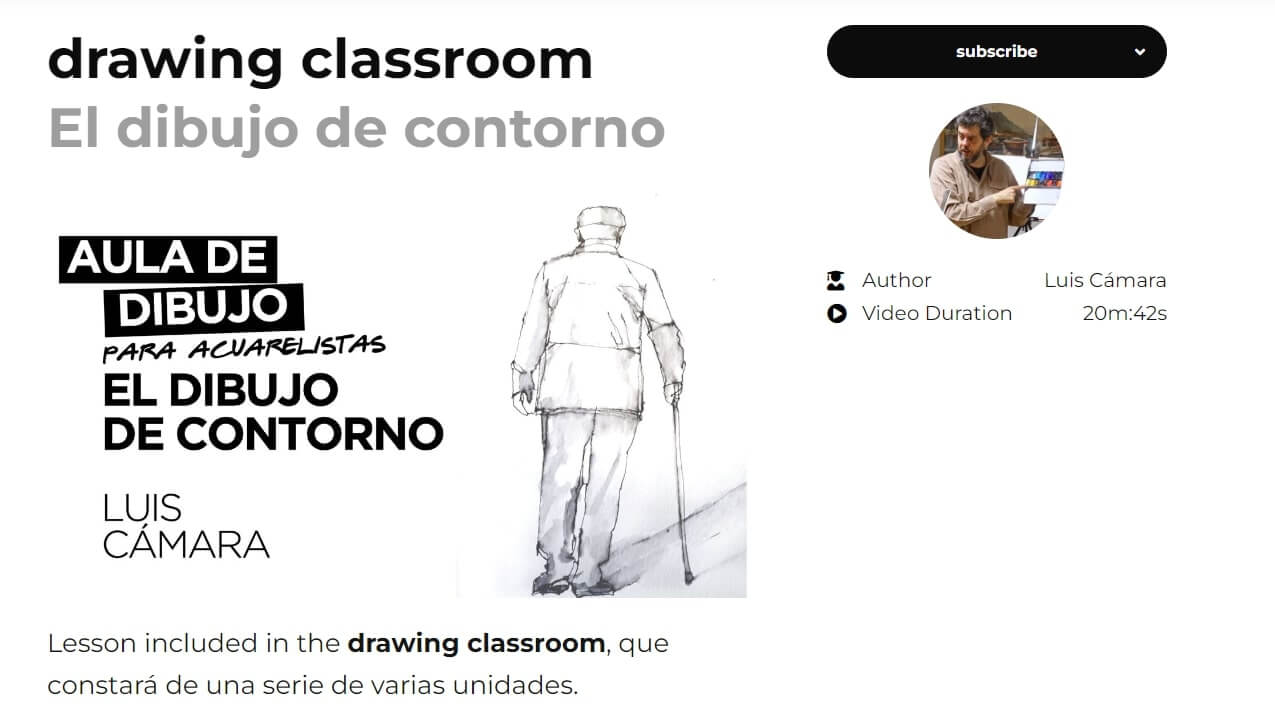
The course description is brief but offers the information students need, including the duration of the course (a 20-minute-long video), the instructor’s name, and the subscription options.

Apart from that, the description of the course offers a special commentary featuring the perspective of the watercolorist and instructor, who explains why he chose to work with watercolor in the first place. This works as a unique selling point, fostering trust between the instructor and potential students.
Imagineer.me – School for critical and creative thinking
Imagineer.me is a school that provides visual learning modules that develop the creative potential of learners. It fuses visual, symbolic, and metaphoric thinking with Aboriginal pedagogy.
Targeting mainly Australian users, it focuses on visualization processes based on neuroscience and visual mapping of paths for students, while offering many more interesting subjects for both teachers and students to explore.
Course title: “The Neuroscience of Imagination”
Their course description on the selected course is structured effectively, listing the course title prominently, the course price, and the course group it belongs to (The V Series), and clearly states for whom this course is: “It is appropriate for all teachers, including math, language, art, science, etc. It is also relevant for pre-school, primary, high school, and university.”
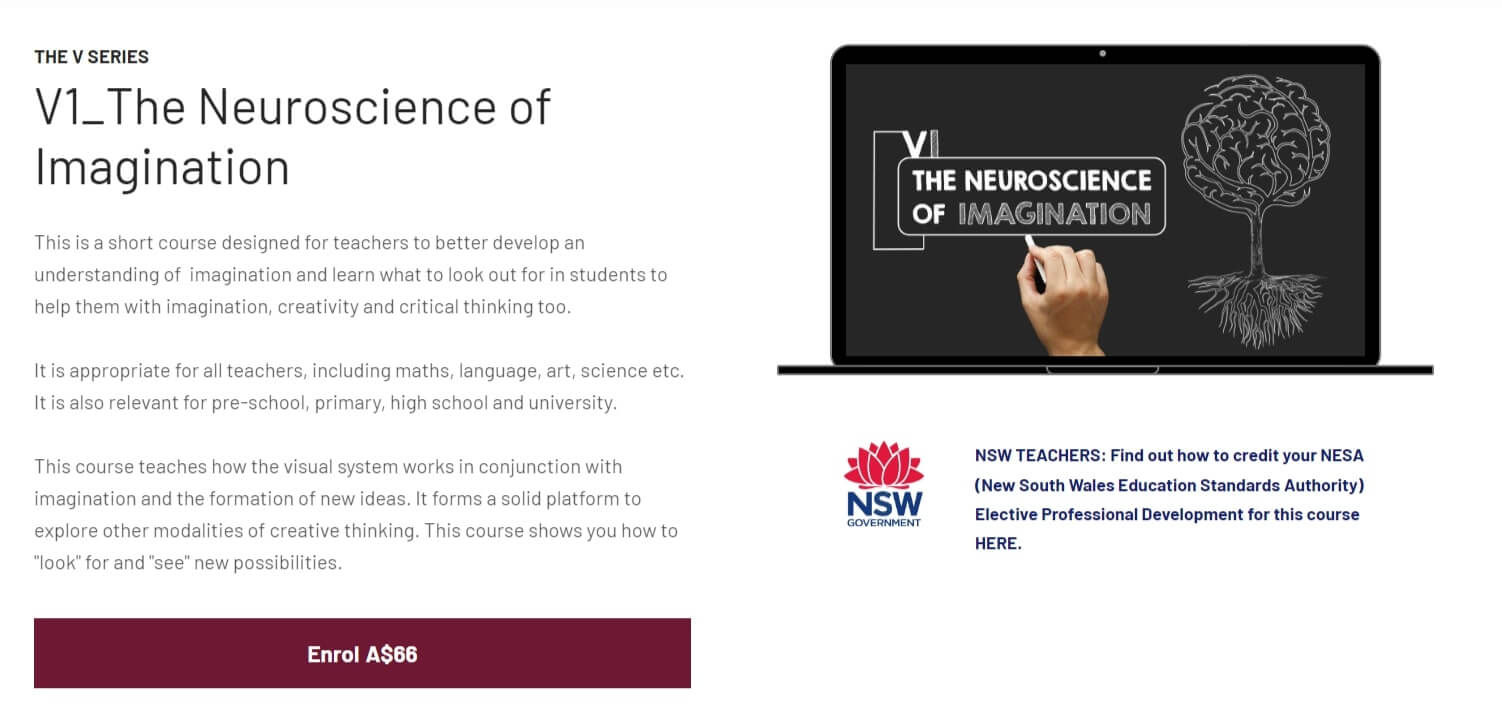
On top of that, it includes a note that informs teachers they can get their NESA credits by enrolling in this course, giving them another reason to join.
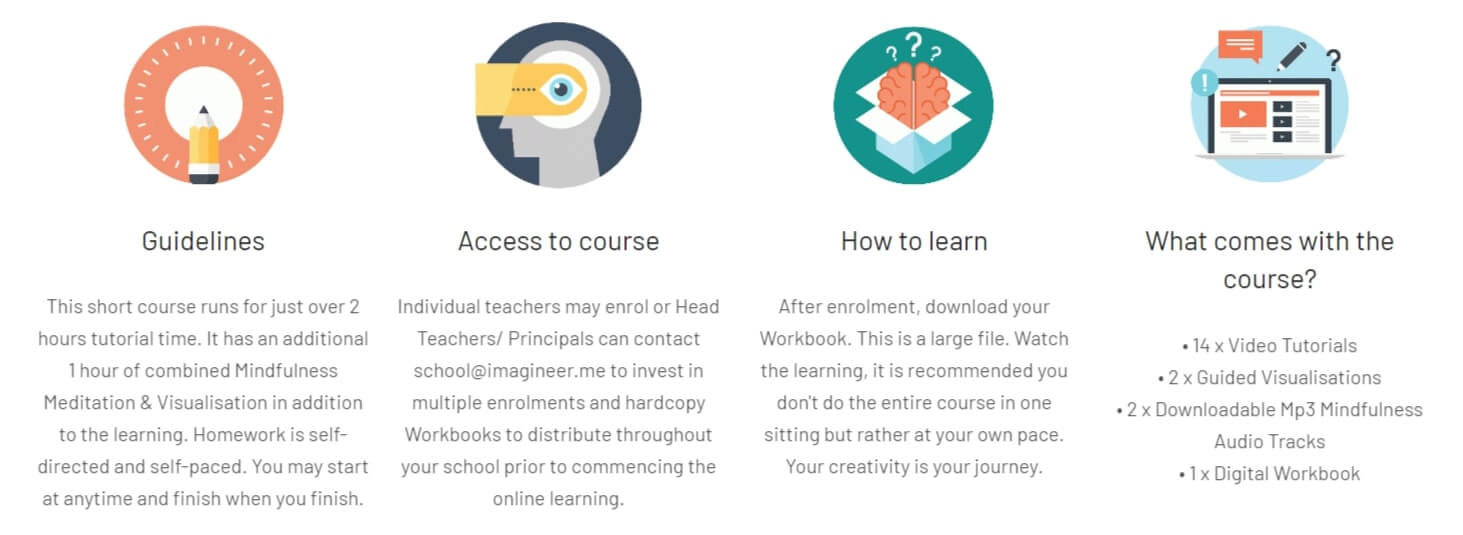
For this course, the school also lists the guidelines and contents on the page and offers additional information for every module. It clearly shows what types of learning activities are included in the outline, like video tutorials, PDFs, audio files, quizzes, and exams.
It also contains numbers to describe its contents eg:
These numbers communicate the value the course offers to its potential students.
FriEdOnline – EdTech professional learning academy
FriEdOnline is an online academy created by FriEdTech—an education technology professional learning and development organization that offers fun, useful, and engaging EdTech professional development.
The company offers a range of training services to educators, and its mission is to empower them through flexible, self-paced learning experiences to build the expertise needed to excel in their field.
Course title: “Rock the Classroom: Classroom Management & Behavior Strategies for Today’s Classroom”
On their course catalog, you can easily see what each course is about. The one we chose for this example of a course description has a visually appealing image and a bold course title and lists the course price, name of instructor, awarded credits, and access duration (12 months).

All these elements are accompanied by a unique and catchy course description that shows it understands the target audience’s pain point and speaks directly to them—teachers who need help managing the classroom.
On the course page, the academy makes use of video and on-page visuals to show the course duration (6 hours) and highlights the benefits of enrolling in the course. With this course, learners will get their certificate and badge and will be able to go through the course content at their own pace.
The course description also lists the course outline, talks about the experts/instructors, and provides reviews, enrollment options, and FAQs. For a more concise and marketable course description sample, it also offers a downloadable course flier!
Dos and don’ts when writing a description of your course
Reviewing course description examples like the ones above is helpful in terms of identifying what works best. As the course creator, however, it’s up to you to decide which approach to follow.
Either way, make sure you are ticking off the following dos and excluding the don’ts:
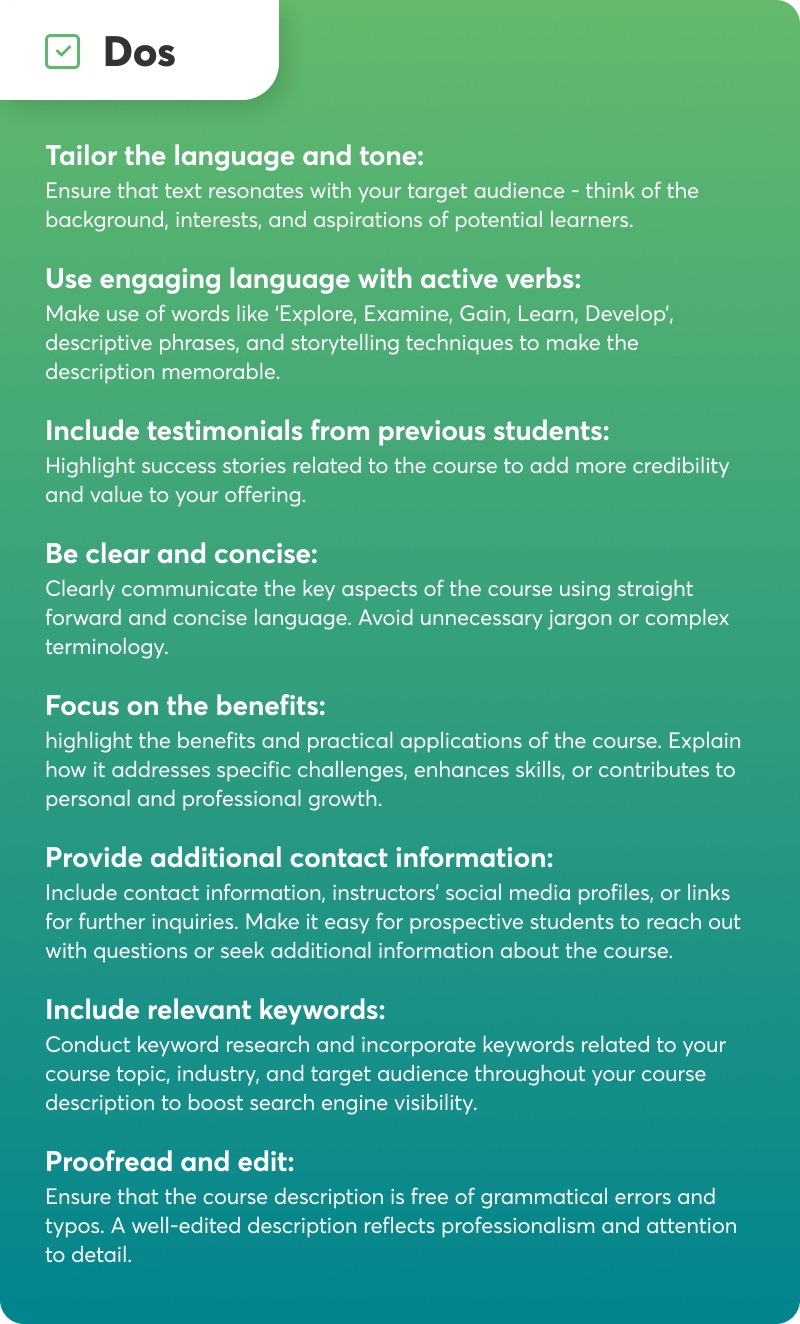
Dos
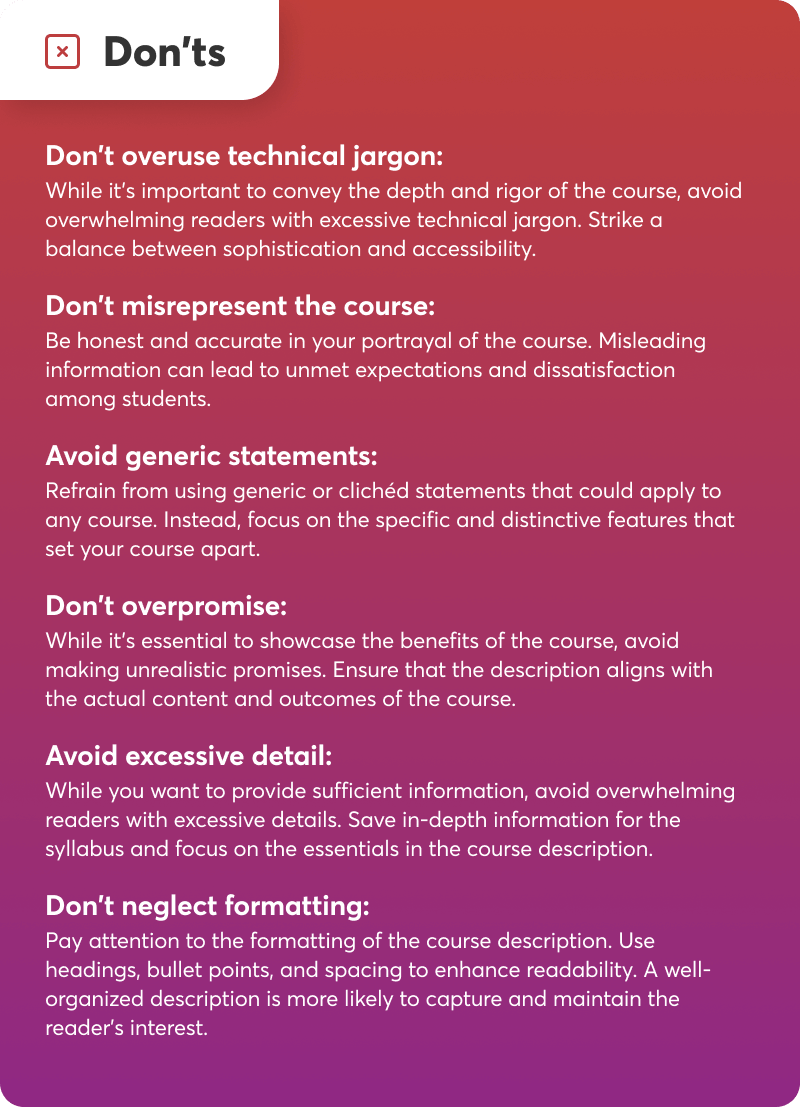
Don’ts
Ready to start creating a description for your online course?
Writing course descriptions is the pivotal step that transforms your educational vision into a compelling and informative narrative for your learners.
A good course description will lay the foundation for attracting the right audience and setting clear expectations. So, as you begin writing yours, consider the unique value your course offers, the specific needs it addresses for your learners, and the outcomes they can anticipate.
Take the opportunity to showcase the distinctive features that make your course stand out and rise above the competition today.
And if you’re searching for an exceptional online course platform to create and promote your online courses, look no further than LearnWorlds. Take advantage of our 30-day free trial to explore the myriad possibilities and unlock your full potential!
Kyriaki is the SEO Content Manager at LearnWorlds, where she writes and edits content about marketing and e-learning, helping course creators build, market, and sell successful online courses. With a degree in Career Guidance and a solid background in education management and career development, she combines strategic insight with a passion for lifelong learning. Outside of work, she enjoys expressing her creativity through music.
FAQ
Everything you have ever wondered, but were too afraid to ask...




